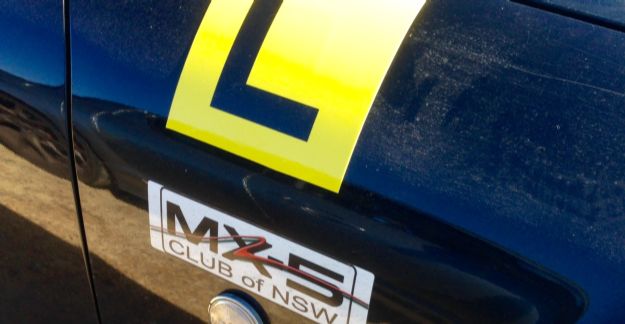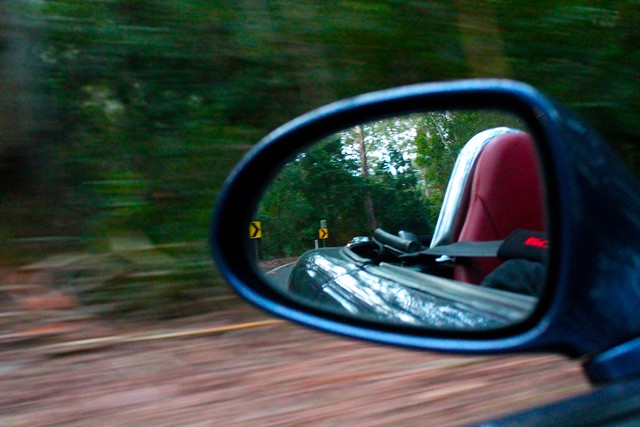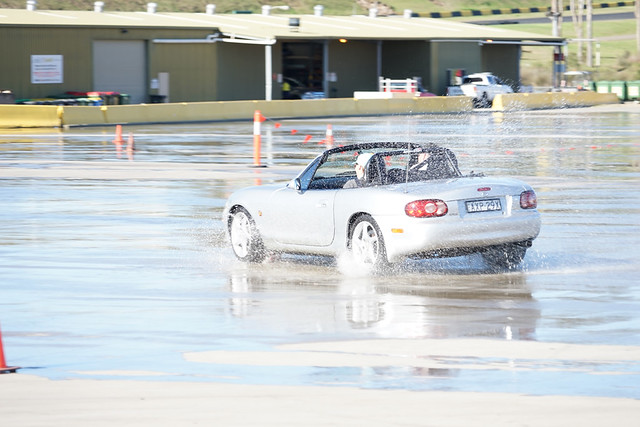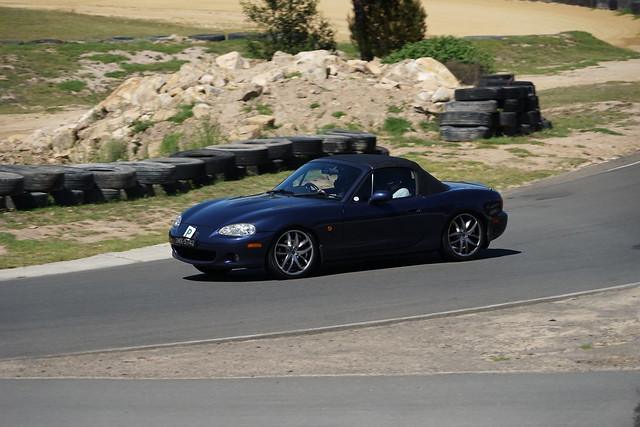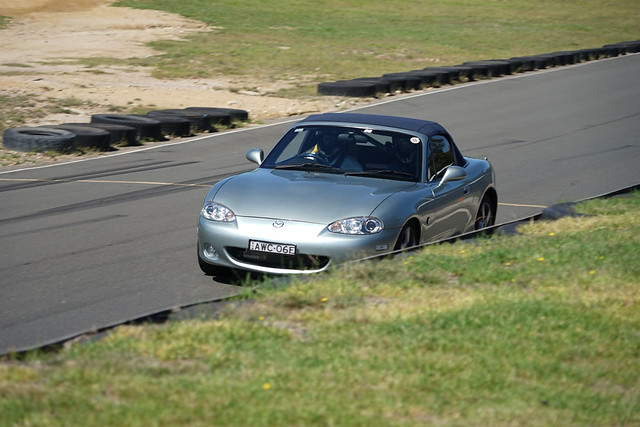Rate the Plate
13 December 2016 / Story by Mel Keller; Photos by Rob Wilkins, Helen Green, Grant Webber, Paige Wilson, Alexandra Breitsameter
When our young drivers appear in the media, it is too often the result of tragedy. The headlines are full of hooning, drink driving, texting P-platers who are a danger to themselves and others. With no good news stories to provide some balance, it is a far too easy to form a negative impression of all young drivers.
Club Torque caught up with two of our young MX-5 drivers; Liam Price from the Hunter Chapter and Alexandra Breitsameter of the Illawarra to discuss the issues and challenges they face. In doing so, we found the good news story. They are capable, thoughtful and dedicated to developing their skills. Like the majority of young drivers, they are just trying to get from A to B. They are successfully undertaking a complex task in an ever changing environment. They are exactly like you and me. Only younger.
When it comes to crash statistics, any number greater than zero is too high. The tragic statistics involving young drivers represent not only fatalities and injuries but also the lost potential of a young life.
Just 16% of all license holders are aged between 17-25 yet they represent over a quarter of all crash casualties. Drivers under the age of 25 are three times more likely to be involved in a crash and, most worryingly, over the last 5 years the number of crashes involving a young fatality has increased from 40% to 53%. There are a large number of causes contributing to the statistics, including speeding, drug and alcohol use, location (young drivers in rural areas are at greater the risk), overconfidence, not wearing seat belts, poor hazard perception, teenage risk taking behaviour and the distractions of having passengers.
By just looking at the numbers, it is easy to stereotype all young drivers as being, by turns; arrogant, incapable, irresponsible and addicted to risk.
But not every plated driver contributes to the statistics and so; not every young driver fits the stereotype. They are from different socio-economic backgrounds, different cultures and have different life experiences. It seems unfair to tar all young drivers with the same brush when, in fact, the only thing young drivers have in common is that they are all young.
For our government and community, keeping young drivers safe is a genuine need that merits constant attention and commitment. But to young drivers, that attention can often feel harsh.
In Australia, it seems we forgo the carrots and bring out the sticks to manage young driver behaviour. There are bans on mobile phone use, strictly enforced speed limits and harsh penalties for infringements. It is all done in the best interest of young drivers but can leave that part of our community feeling spotlighted, intimidated and marginalised.
L and P plates are displayed for safety to show that a driver is operating with a speed restriction and may be under instruction. The plates are a signal to give that driver some additional space, especially on our highways. As Alexandra explains; “the then 80kph speed limit for L platers (now 90kph) I found to be nigh-on dangerously impractical in busy highway merging scenarios. People just zap into your safety gap with no by your leave!”
It seems that highway driving is a major issue for young drivers. “My parents taught me the correct driving code, especially highway etiquette”, says Liam. “Being from Europe, they would constantly note how dangerous it is for people to hog the overtaking lane.”
As anyone who has supervised a Learner driver, being the target of frustrated drivers trying to get around a right lane hog is unpleasant, stressful and potentially dangerous.
Not everybody is prepared to commit to the hard work and responsibility involved in obtaining a licence. In Australia and around the world, the numbers of young people pursuing a driver’s license are in a steady decline. This is partly due to the modern, urban lifestyle. A car isn’t considered essential by millennials who are studying, travelling and living at home for longer. Social media and mobile devices have replaced going into town to do blockies when you want to catch up with friends and the financial burden of motoring has increased. The costs of fuel, parking and insurance are on the rise and as cars become more mechanically complex, so too the cost of basic maintenance.
Perhaps the greatest hurdle however, is the licensing process itself. It takes over 36 months to attain a full license and the recent addition of the Hazard Perception Test to the mandatory requirements in NSW, has added to the overall cost. Surveys of young people have also shown that the 120 hours of supervised practice can be a deterrent, with one respondent commenting; “that’s a lot of time to spend with your olds”.
Overcoming these barriers takes dedication, discipline and effort. Those “L” and “P” plates represent countless hours of saving up, test taking and practice and are always sought for the right reasons.
These days, a driver’s licence is no longer seen as a God-given right of passage. It is a tool for transporting friends and family and a safety net in emergencies. And a licence can be essential for getting to work.
“Living on the Central Coast, public transport has not always been readily available and, with a two hour daily commute to work, the freedom of driving is priceless”, says Liam. For Alex, independence and practicality are key. “I never much liked having to ask my parents for a lend of their cars. I also enjoy driving so much, I can't imagine not having a car.”
A recent NZ study found that young drivers are at greater higher risk of crashes because they are still developing their higher order driving skills. Experienced drivers take for granted their ability to scan the environment and use peripheral vision, to detect and assess hazards, anticipate other drivers’ moves and to identify and reduce risk. But young drivers must learn these complex skills and then practice them in a range of real life driving situations and conditions.
So does our testing and licensing process cover all the basics necessary for young driver safety?
Getting to grips with the road rules was pretty easy according to Alexandra. “The computer based knowledge tests for the “L” and green “P” plates were ludicrously easy and the hardest part of the practical test involved a reverse park into a spot that you could have driven a school bus into. This didn't prepare me for real-world trips into Sydney where I have to reverse park into a spot just bigger than my shoe - whilst braving the hurried scorn of a growing line of cars. And we received a driving log for our “P“ plates where we only needed a token 20 hours of night driving, which seemed strangely uneven to me.”
Alexandra was lucky enough to learn car control by paddock bashing in her Dad’s Econovan and Nissan 4x4 but for most young drivers in the city, finding a safe space to overcome the bunny hop is next to impossible. Liam learned to drive with NRMA Safe Driver lessons and found them invaluable for passing the practical test. But he also believes the lessons could have included more practical, defensive driving skills such as wet weather safety and skid avoidance and how to manage oversteer and understeer.
There are a range of options to help young drivers develop their higher order skills. The Victorian Government funds the Drive Smart website which features a host of interactive challenges to improve concentration, scanning and peripheral vision. In NSW, the Hazard Perception Test training site uses real life traffic footage for users to practice braking distances, gap selection and lane changing. And insurance company AAMI have a Safe Driver App that helps young drivers monitor their acceleration control and braking techniques.
A valuable feature of these programs are the elements of positive reinforcement and reward. With Hall of Fame rankings, insurance discounts and quarterly prizes, these sites put the stick down and dole out the carrots to mentor our young drivers - with great success.
There are also two very important ways the MX-5 Club of NSW is supporting our young drivers; Motorkhana and Marulan Driver Training days. Club Motorkhanas are held at Sydney Motorsport Park and feature a series of timed tests on a watered skidpan. Motorkhanas are a safe and fun way to develop braking and cornering techniques in “wet weather” conditions and provide the perfect environment for a young driver to spend time getting to know the sound and feel of their car. Driving on a skid pan can teach a lot about the effects of Traction and Dynamic Stability Control and how the ABS behaves and sounds during an emergency stop. It also provides valuable time away from the traffic to practice correct steering and gearing.
Club Driver Training Days have been operating at the purpose built Marulan Driver Training Centre for over two years. They provide a friendly, non-competitive atmosphere for all members who want to develop and practice controlled acceleration, cornering and braking techniques. They are also a great chance to get advice on setting up driver position, cabin controls, instruments, mirrors and tyre pressures.
“I have found my participation in the Marulan Driver Training Day and Motorkhana skidpan days to be of much more use than formal driving lessons,” says Liam. “It allowed me to experience the scenario of oversteer and understeer in a safe and controlled environment. I can apply these skills in a real world scenario, whether it be an evasive manoeuvre or a patch of oil at a roundabout. I will continue to take part in driver training experiences like these because the development of driving ability never stops. These training days are a great experience no matter what an individual’s driving ability’. Liam’s insurance company agrees. By participating in Club Marulan Driver Training days, Liam has earned “safe and responsible” driver status which translates to a $240 discount on his annual premium.
Alexandra has progressed from Driver Training Days to Club Track Days at Wakefield Park Raceway. “I'd never considered track day events when I join the Club but I was consistently encouraged to have a go by everyone I talked to, in particular, Gaynor and David Lawler who made it possible for a beginners group to learn together. Being involved in several trackdays has given me the opportunity to find the limits of my car and my own driving ability and to begin to nudge those forward. That's been invaluable, because the only time that would otherwise happen would be on the public roads and that would be when something has gone terribly wrong.”
So how does the MX-5 rate as a suitable first car for a young driver?
Alexandra is the proud owner of a 2003 NB8B Classic Edition in Cerion Silver (1 of only 100 imported to Australia). It is mechanically completely standard but equipped with roll bar, race seat and harness. “There is the ever-present temptation to swap out the suspension for a lower set as I did with my mother's 2002 NB8B,” she says. “But this is usually stymied by the prospect of see-sawing over the speed humps at the local shops (as she now does!)”. Liam’s 2001 NB8B has been lightly modified with Bilstein shocks, carbon fibre cold air intake and stainless steel exhaust.
Both believe the MX-5 is an ideal first car for a young driver. With its rear wheel drive configuration and lightweight chassis, the MX-5 has the right weight balance for highly predictable and controllable steering. The car offers instant and unmistakable feedback to the driver during acceleration and braking and in addition to ABS, TC and DSC, later models have forward collision warning, automatic emergency braking and lane assist. MX-5s are mechanically solid and can take a lot of abuse from a learner without needing expensive repairs and they are also economical to maintain and run. And a two seater car provides less opportunity for passengers whose behaviour could distract a young driver.
“The MX-5 is a terrific and forgiving teacher for people looking to drive well,” states Alexandra, “but push the envelope a tad far in an MX-5 and it’ll spank, but gently.” Liam agrees. “I believe the MX-5 is the ideal first car for responsible car enthusiast but it is still a sports car and putting it in the hands of an inexperienced driver with the ego of a rock star could be risky.”
So, the MX-5 is the right car – for the right person. A person who is ready for the responsibility of holding a license and is committed to ongoing development and training. A person who knows that if they respect their MX-5, it will always look after them.
Alexandra believes the MX-5 Club is doing a superb job of supporting and assisting young drivers and is looking forward to learning some basic mechanics from more experienced club members. “I want to change my own brake pads, swap out rotors and generally tinker with the car responsibly and I know how much knowledge there is in the Club.”
Liam also sees the benefits of membership for a young driver. “I can safely say that I am happy and proud to be part of a club that caters to all club members whether it be track day enthusiasts, casual cruisers or spirited drivers. I’ve made lifelong friends with some outstanding people.”
As a driving community, there is much we can do to embrace and encourage our young drivers. We can give those “L” and “P” plates a bit more time and space and model the driving behaviour we would like to see. We can holster the mobile phone and that middle finger and try to drive a mile in their shoes. And when we see a young driver out on the road, we can do well to remember that no matter where they’re going, we’ve all been there.

